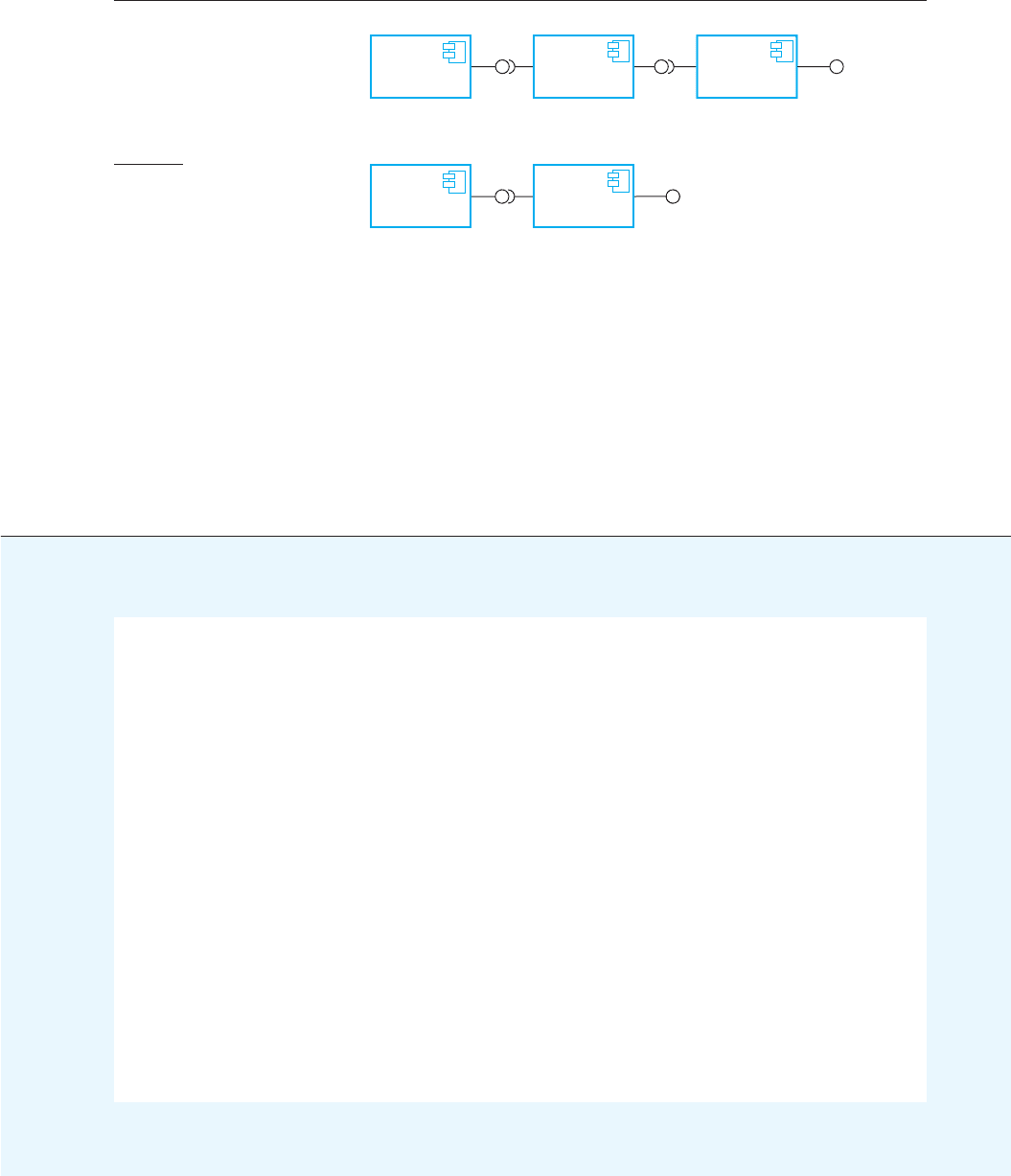Sommerville I. Software Engineering (9th edition)
Подождите немного. Документ загружается.


474 Chapter 17 ■ Component-based software engineering
3. The post-conditions for addItem state that:
The size of the library has increased by 1 (so only a single entry has been made).
If you retrieve using the same identifier, then you get back the photograph
that you added.
If you look up the catalogue using that identifier, you get back the catalogue
entry that you made.
The specification of delete provides further information. The pre-condition states
that to delete an item, it must be in the library and, after deletion, the photo can no
longer be retrieved and the size of the library is reduced by 1. However, delete does
not delete the catalogue entry—you can still retrieve it after the photo has been
deleted. The reason for this is that you may wish to maintain information in the cat-
alog about why a photo was deleted, its new location, and so on.
When you create a system by composing components, you may find that there are
potential conflicts between functional and non-functional requirements, the need to
deliver a system as quickly as possible and the need to create a system that can
evolve as requirements change. The decisions where you may have to take trade-offs
into account are:
1. What composition of components is most effective for delivering the functional
requirements for the system?
2. What composition of the components will make it easier to adapt the composite
component when its requirements change?
3. What will be the emergent properties of the composed system? These are prop-
erties such as performance and dependability. You can only assess these once
the complete system is implemented.
Unfortunately, there are many situations where the solutions to the composition
problems may conflict. For example, consider a situation such as that illustrated in
Figure 17.15, where a system can be created through two alternative compositions.
The system is a data collection and reporting system where data is collected from
different sources, stored in a database and then different reports summarizing that
data are produced.
Here, there is a potential conflict between adaptability and performance.
Composition (a) is more adaptable but composition (b) is perhaps faster and more
reliable. The advantages of composition (a) are that reporting and data management
are separate, so there is more flexibility for future change. The data management
system could be replaced and, if reports are required that the current reporting com-
ponent cannot produce, that component can also be replaced without having to
change the data management component.
In composition (b), a database component with built-in reporting facilities (e.g.,
Microsoft Access) is used. The key advantage of composition (b) is that there are fewer
components, so this will be a faster implementation because there are no component

Chapter 17 ■ Key points 475
communication overheads. Furthermore, data integrity rules that apply to the database
will also apply to reports. These reports will not be able to combine data in incorrect
ways. In composition (a), there are no such constraints so errors in reports could occur.
In general, a good composition principle to follow is the principle of separation of
concerns. That is, you should try to design your system in such a way that each com-
ponent has a clearly defined role and that, ideally, these roles should not overlap.
However, it may be cheaper to buy one multi-functional component rather than two
or three separate components. Furthermore, there may be dependability or perform-
ance penalties when multiple components are used.
(a)
Data
Collection
(b)
Data
Management
Report
Generator
Data
Collection
Data Base
Report
Report
Figure 17.15 Data
collection and report
generation components
K E Y P O I N T S
■ Component-based software engineering is a reuse-based approach to defining, implementing,
and composing loosely coupled independent components into systems.
■ A component is a software unit whose functionality and dependencies are completely defined by
a set of public interfaces. Components can be composed with other components without
knowledge of their implementation and can be deployed as an executable unit.
■ Components may be implemented as program units that are included in a system or as external
services that are referenced from within a system.
■ A component model defines a set of standards for components, including interface standards,
usage standards, and deployment standards. The implementation of the component model
provides a set of common services that may be used by all components.
■ During the CBSE process, you have to interleave the processes of requirements engineering and
system design. You have to trade off desirable requirements against the services that are
available from existing reusable components.
■ Component composition is the process of ‘wiring’ components together to create a system.
Types of composition include sequential composition, hierarchical composition, and additive
composition.

476 Chapter 17 ■ Component-based software engineering
■ When composing reusable components that have not been written for your application, you
may need to write adaptors or ‘glue code’ to reconcile the different component interfaces.
■ When choosing compositions, you have to consider the required functionality of the system,
the non-functional requirements and the ease with which one component can be replaced when
the system is changed.
F U RT H E R R E A D I N G
Component-based Software Engineering: Putting the Pieces Together. This book is a collection of
papers from various authors on different aspects of CBSE. Like all collections, it is rather mixed but
it has better coverage of general issues of software engineering with components than Szyperski’s
book. (G. T. Heineman and W. T. Councill, Addison-Wesley, 2001.)
Component Software: Beyond Object-Oriented Programming, 2nd ed. This updated edition of the
first book on CBSE covers technical and nontechnical issues in CBSE. It has more detail on specific
technologies than Heineman and Councill’s book and includes a thorough discussion of market
issues. (C. Szyperski, Addison-Wesley, 2002.)
‘Specification, Implementation and Deployment of Components’. A good introduction to the
fundamentals of CBSE. The same issue of the CACM includes articles on components and
component-based development. (I. Crnkovic, B. Hnich, T. Jonsson and Z. Kiziltan, Comm. ACM,
45 (10), October 2002.) http://dx.doi.org/10.1145/570907.570928.
‘Software Component Models’. This is a comprehensive discussion of commercial and research
component models that classifies these models and explains the differences between them. (K-K.
Lau and Z. Wang, IEEE Transactions on Software Engineering, 33 (10), October 2007.)
http://dx.doi.org/10.1109/TSE.2007.70726.
E X E R C I S E S
17.1. Why is it important that all component interactions are defined through ‘requires’ and
‘provides’ interfaces?
17.2. The principle of component independence means that it ought to be possible to replace one
component with another that is implemented in a completely different way. Using an example,
explain how such component replacement could have undesired consequences and may lead
to system failure.

Chapter 17 ■ References 477
17.3. What are the fundamental differences between components as program elements and
components as services?
17.4. Why is it important that components should be based on a standard component model?
17.5. Using an example of a component that implements an abstract data type such as a stack or a
list, show why it is usually necessary to extend and adapt components for reuse.
17.6. Explain why it is difficult to validate a reusable component without the component source
code. In what ways would a formal component specification simplify the problems of
validation?
17.7. Design the ‘provides’ interface and the ‘requires’ interface of a reusable component that may
be used to represent a patient in the MHC-PMS.
17.8. Using examples, illustrate the different types of adaptor needed to support sequential
composition, hierarchical composition, and additive composition.
17.9. Design the interfaces of components that might be used in a system for an emergency
control room. You should design interfaces for a call-logging component that records calls
made, and a vehicle discovery component that, given a post code (zip code) and an incident
type, finds the nearest suitable vehicle to be despatched to the incident.
17.10. It has been suggested that an independent certification authority should be established.
Vendors would submit their components to this authority, which would validate that the
component was trustworthy. What would be the advantages and disadvantages of such a
certification authority?
R E F E R E N C E S
Boehm, B. W., Abts, C., Brown, A. W., Chulani, S., Clark, B. K., Horowitz, E., Madachy, R., Reifer, D. and
Steece, B. (2000). Software Cost Estimation with COCOMO II. Upper Saddle River, NJ.: Prentice Hall.
Councill, W. T. and Heineman, G. T. (2001). ‘Definition of a Software Component and its Elements’. In
Component-based Software Engineering. Heineman, G. T. and Councill, W. T. (ed.). Boston: Addison-
Wesley, 5–20.
Jacobson, I., Griss, M. and Jonsson, P. (1997). Software Reuse. Reading, Mass.: Addison-Wesley.
Kotonya, G. (2003). ‘The CBSE Process: Issues and Future Visions’. Proc. 2nd CBSEnet workshop,
Budapest, Hungary.
Lau, K.-K. and Wang, Z. (2007). ‘Software Component Models’. IEEE Trans. on Software Eng., 33 (10),
709–24.
Meyer, B. (1992). ‘Design by Contract’. IEEE Computer, 25 (10), 40–51.
Meyer, B. (2003). ‘The Grand Challenge of Trusted Components’. ICSE 25: Int. Conf. on Software Eng.,
Portland, Oregon: IEEE Press.

478 Chapter 17 ■ Component-based software engineering
Mili, H., Mili, A., Yacoub, S. and Addy, E. (2002). Reuse-based Software Engineering. New York: John
Wiley & Sons.
Pope, A. (1997). The CORBA Reference Guide: Understanding the Common Object Request Broker
Architecture. Harlow, UK: Addison-Wesley.
Szyperski, C. (2002). Component Software: Beyond Object-oriented Programming, 2nd ed. Harlow,
UK: Addison-Wesley.
Warmer, J. and Kleppe, A. (2003). The Object Constraint Language: Getting your models ready for
MDA. Boston: Addison-Wesley.
Weinreich, R. and Sametinger, J. (2001). ‘Component Models and Component Services: Concepts and
Principles’. In Component-Based Software Engineering. Heineman, G. T. and Councill, W. T. (ed.).
Boston: Addison-Wesley, 33–48.

Distributed software
engineering
18
Objectives
The objective of this chapter is to introduce distributed systems
engineering and distributed systems architectures. When you have read
this chapter, you will:
■ know the key issues that have to be considered when designing and
implementing distributed software systems;
■ understand the client–server computing model and the layered
architecture of client–server systems;
■ have been introduced to commonly used patterns for distributed
systems architectures and know the types of system for which each
architecture is most applicable;
■ understand the notion of software as a service, providing web-based
access to remotely deployed application systems.
Contents
18.1 Distributed systems issues
18.2 Client–server computing
18.3 Architectural patterns for distributed systems
18.4 Software as a service

480 Chapter 18 ■ Distributed software engineering
Virtually all large computer-based systems are now distributed systems. A distrib-
uted system is one involving several computers, in contrast with centralized systems
where all of the system components execute on a single computer. Tanenbaum and
Van Steen (2007) define a distributed system to be:
“. . .a collection of independent computers that appears to the user as a single
coherent system.”
Obviously, the engineering of distributed systems has a great deal in common
with the engineering of any other software. However, there are specific issues that
have to be taken into account when designing this type of system. These arise
because the system components may be running on independently managed comput-
ers and they communicate across a network.
Coulouris et al. (2005) identify the following advantages of using a distributed
approach to systems development:
1. Resource sharing A distributed system allows the sharing of hardware and soft-
ware resources—such as disks, printers, files, and compilers—that are associ-
ated with computers on a network.
2. Openness Distributed systems are normally open systems, which means that
they are designed around standard protocols that allow equipment and software
from different vendors to be combined.
3. Concurrency In a distributed system, several processes may operate at the same
time on separate computers on the network. These processes may (but need not)
communicate with each other during their normal operation.
4. Scalability In principle at least, distributed systems are scalable in that the capa-
bilities of the system can be increased by adding new resources to cope with
new demands on the system. In practice, the network linking the individual
computers in the system may limit the system scalability.
5. Fault tolerance The availability of several computers and the potential for repli-
cating information means that distributed systems can be tolerant of some hard-
ware and software failures (see Chapter 13). In most distributed systems, a
degraded service can be provided when failures occur; complete loss of service
only occurs when there is a network failure.
For large-scale organizational systems, these advantages mean that distributed
systems have largely replaced mainframe legacy systems that were developed in the
1990s. However, there are many personal computer application systems (e.g., photo
editing systems) that are not distributed and which run on a single computer system.
Most embedded systems are also single processor systems.
Distributed systems are inherently more complex than centralized systems. This
makes them more difficult to design, implement, and test. It is harder to understand
the emergent properties of distributed systems because of the complexity of the

18.1 ■ Distributed systems issues 481
interactions between system components and the system infrastructure. For example,
rather than the performance of the system being dependent on the execution speed of
one processor, it depends on the network bandwidth, the network load, and the speed
of all of the computers that are part of the system. Moving resources from one part of
the system to another can significantly affect the system’s performance.
Furthermore, as all users of the WWW know, distributed systems are unpredictable
in their response. The response time depends on the overall load on the system, its archi-
tecture and the network load. As all of these may change over a short time, the time
taken to respond to a user request may vary dramatically from one request to another.
The most important development that has affected distributed software systems in
the past few years is the service-oriented approach. Much of this chapter focuses on
general issues of distributed systems, but I cover the notion of applications deployed
as services in Section 18.4. This complements the material in Chapter 19, which
focuses on services as components in a service-oriented architecture, and more gen-
eral issues of service-oriented software engineering.
18.1 Distributed systems issues
As I discussed in the introduction to this chapter, distributed systems are more com-
plex than systems that run on a single processor. This complexity arises because it is
practically impossible to have a top-down model of control of these systems. The
nodes in the system that deliver functionality are often independent systems with no
single authority in charge of them. The network connecting these nodes is a sepa-
rately managed system. It is a complex system in its own right and cannot be con-
trolled by the owners of systems using the network. There is therefore an inherent
unpredictability in the operation of distributed systems that has to be taken into
account by the system designer.
Some of the most important design issues that have to be considered in distributed
systems engineering are:
1. Transparency To what extent should the distributed system appear to the user
as a single system? When it is useful for users to understand that the system is
distributed?
2. Openness Should a system be designed using standard protocols that support
interoperability or should more specialized protocols be used that restrict the
freedom of the designer?
3. Scalability How can the system be constructed so that it is scaleable? That is,
how can the overall system be designed so that its capacity can be increased in
response to increasing demands made on the system?
4. Security How can usable security policies be defined and implemented that
apply across a set of independently managed systems?

482 Chapter 18 ■ Distributed software engineering
5. Quality of service How should the quality of service that is delivered to system
users be specified and how should the system be implemented to deliver an
acceptable quality of service to all users?
6. Failure management How can system failures be detected, contained (so that
they have minimal effects on other components in the system), and repaired?
In an ideal world, the fact that a system is distributed would be transparent to
users. This means that users would see the system as a single system whose behavior
is not affected by the way that the system is distributed. In practice, this is impossi-
ble to achieve. Central control of a distributed system is impossible and, as a result,
individual computers in a system may behave differently at different times.
Furthermore, because it always takes a finite length of time for signals to travel
across a network, network delays are unavoidable. The length of these delays
depends on the location of resources in the system, the quality of the user’s network
connection, and the network load.
The design approach to achieving transparency depends on creating abstractions
of the resources in a distributed system so that the physical realization of these
resources can be changed without having to make changes in the application system.
Middleware (discussed in Section 18.1.2) is used to map the logical resources refer-
enced by a program onto the actual physical resources, and to manage the interac-
tions between these resources.
In practice, it is impossible to make a system completely transparent and users,
generally, are aware that they are dealing with a distributed system. You may there-
fore decide that it is best to expose the distribution to users. They can then be pre-
pared for some of the consequences of distribution such as network delays, remote
node failures, etc.
Open distributed systems are systems that are built according to generally
accepted standards. This means that components from any supplier can be integrated
into the system and can interoperate with the other system components. At the
networking level, openness is now taken for granted with systems conforming to
Internet protocols but at the component level, openness is still not universal.
Openness implies that system components can be independently developed in any
programming language and, if these conform to standards, they will work with other
components.
CORBA – Common Object Request Broker Architecture
CORBA is a well-known specification for a middleware system that was developed in the 1990s by the Object
Management Group. It was intended as an open standard that would allow the development of middleware to
support distributed component communications and execution, plus provide a set of standard services that
could be used by these components.
Several implementations of CORBA were produced but the system never achieved critical mass. Users preferred
proprietary systems or moved to service-oriented architectures.
http://www.SoftwareEngineering-9.com/Web/DistribSys/Corba.html

18.1 ■ Distributed systems issues 483
The CORBA standard (Pope, 1997) developed in the 1990s, was intended to
achieve this but this never achieved a critical mass of adopters. Rather, many compa-
nies chose to develop systems using proprietary standards for components from
companies such as Sun and Microsoft. These provided better implementations and
support software and better long-term support for industrial protocols.
Web service standards (discussed in Chapter 19) for service-oriented architec-
tures were developed to be open standards. However, there is significant resistance
to these standards because of their perceived inefficiency. Some developers of serv-
ice-based systems have opted instead for so-called RESTful protocols as these have
an inherently lower overhead than web service protocols.
The scalability of a system reflects its ability to deliver a high quality of service
as demands on the system increase. Neuman (1994) identifies three dimensions of
scalability:
1. Size It should be possible to add more resources to a system to cope with
increasing numbers of users.
2. Distribution It should be possible to geographically disperse the components of
a system without degrading its performance.
3. Manageability It should be possible to manage a system as it increases in size,
even if parts of the system are located in independent organizations.
In terms of size, there is a distinction between scaling up and scaling out. Scaling up
means replacing resources in the system with more powerful resources. For example,
you may increase the memory in a server from 16 GB to 64 GB. Scaling out means
adding additional resources to the system (e.g., an extra web server to work alongside
an existing server). Scaling out is often more cost effective than scaling up but usually
means that the system has to be designed so that concurrent processing is possible.
I have discussed general security issues and issues of security engineering in Part 2
of this book. However, when a system is distributed, the number of ways that the sys-
tem may be attacked is significantly increased, compared to centralized systems. If a
part of the system is successfully attacked then the attacker may be able to use this as
a ‘back door’ into other parts of the system.
The types of attacks that a distributed system must defend itself against are the
following:
1. Interception, where communications between parts of the system are inter-
cepted by an attacker so that there is a loss of confidentiality.
2. Interruption, where system services are attacked and cannot be delivered as
expected. Denial of service attacks involve bombarding a node with illegitimate
service requests so that it cannot deal with valid requests.
3. Modification, where data or services in the system are changed by an attacker.
4. Fabrication, where an attacker generates information that should not exist and
then uses this to gain some privileges. For example, an attacker may generate a
false password entry and use this to gain access to a system.
